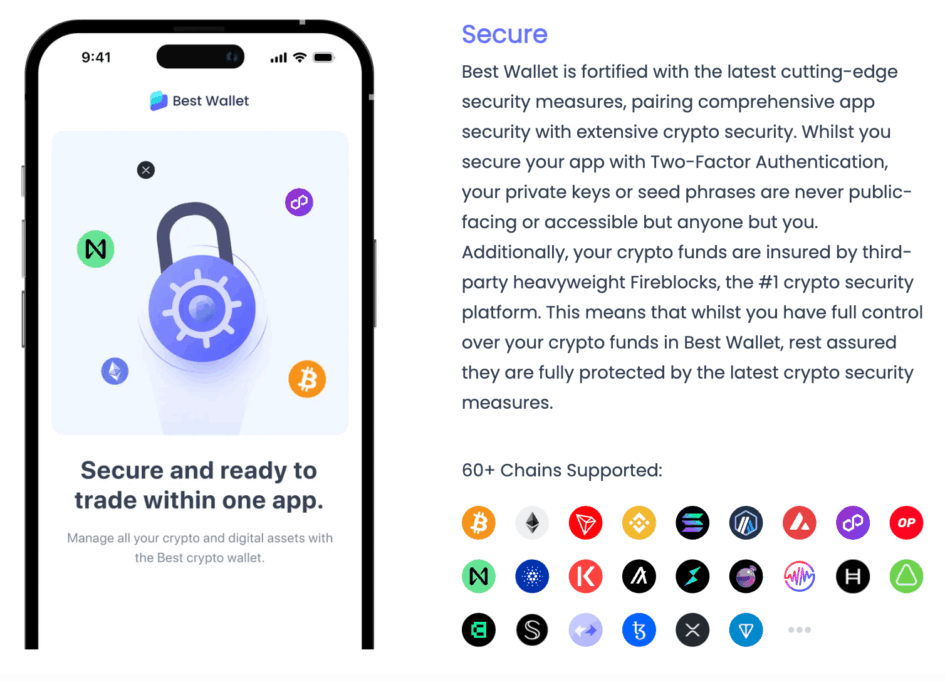SIM swaps, phishing attacks and exchange breaches are costing investors billions, with Bybit’s $1.5B Ethereum hack the latest wake-up call. As crypto security challenges intensify, tools like Best Wallet are positioning themselves as gateways to a safer Web3.
For crypto investors, 2025 has already been a bruising year. From targeted SIM swaps to multi-billion-dollar exchange hacks, the scale of attacks is increasing and the sophistication of bad actors is keeping pace.
SIM swapping is particularly insidious. Attackers trick mobile carriers into transferring a victim’s phone number onto a new SIM card they control. Once active, they intercept one-time passwords and two-factor authentication codes, allowing them to drain crypto wallets, hijack exchange accounts and even take over a victim’s identity.
Other variations – such as SIM cloning, remote SIM vulnerabilities and physical SIM theft – only add to the arsenal.
The appeal for hackers is clear. Cryptocurrency transactions are irreversible, funds can be laundered across chains and big holders are easy to identify through on-chain research. Even seasoned investors can fall prey to sudden network disconnections or suspicious messages, both telltale signs of a SIM swap in progress.
If SIM swaps expose individuals, centralised exchange breaches show how institutions can be just as vulnerable. Bybit, the world’s second-largest exchange, recently suffered what is believed to be the largest single crypto theft in history: $1.5 billion in Ethereum drained from a warm wallet during a routine transfer.
While Bybit has pledged to cover losses, the hack spooked markets, triggered 350,000 withdrawal requests and briefly knocked ETH down 4%.
For the industry, the message is clear: centralised points of failure remain prime targets. Whether it’s a carrier representative falling for pretexting or a warm wallet security gap, attackers exploit human and technical weak links alike.
Why Web3 Needs Stronger Gateways
Both SIM swaps and exchange hacks highlight the fragility of existing security practices. Reliance on SMS-based authentication remains widespread, despite years of warnings. Exchanges continue to pool billions in hot and warm wallets, creating honeypots for state-sponsored hacker groups such as North Korea’s Lazarus Group.
This is where Web3 wallets and particularly non-custodial solutions – are gaining traction. By eliminating the need for centralised storage and putting private keys back in the hands of users, these wallets offer a different trade-off: more responsibility, but also more resilience.
However, not all wallets are equal. Legacy hardware wallets like Ledger or Trezor provide offline protection but sacrifice usability and real-time access. Popular software wallets like MetaMask offer convenience but lack integrated tools for research, presales, or staking. For many retail investors, juggling multiple apps is a barrier.
Enter solutions like Best Wallet, which attempt to bundle usability, security and discovery into a single platform – one that feels Web2-friendly but retains Web3’s principles of control and privacy.
Best Wallet: An All-in-One Approach
At its core, Best Wallet is a non-custodial, multi-chain hot wallet supporting over 60 blockchains. Like MetaMask or TrustWallet, it puts users in control of their private keys, but unlike those incumbents, it layers additional features aimed at both seasoned traders and crypto newcomers.
One of its standout innovations is Upcoming Tokens, a presale and launchpad hub integrated directly into the wallet. Instead of hunting down presale links on Telegram or Discord – often rife with scams – users can access vetted opportunities from within the app itself.
Best Wallet also emphasises multi-chain asset management, allowing users to monitor, stake and swap assets across Bitcoin, Ethereum, Solana, BNB Chain and more – all from a single interface. The app’s portfolio tracker provides real-time performance data, while social features let users follow trending tokens and successful wallets, mirroring strategies from the broader crypto community.
For security, Best Wallet uses multi-party computation (MPC) to split and encrypt private keys, making them harder to compromise even if one device is lost. Biometric authentication and optional encrypted backups provide added convenience without handing custody back to the provider.

Linking the Dots: From SIM Swaps to Self-Custody
The connection between SIM swaps, exchange hacks and Web3 wallets is not theoretical – it’s practical. Many of the largest thefts in crypto history exploited centralized chokepoints: a phone carrier’s customer service desk, a single warm wallet managing billions, or a lack of redundancy in private key storage.
By contrast, Best Wallet removes several of these choke points. Because it doesn’t rely on SMS authentication, SIM swaps cannot compromise the account. Because it is non-custodial, user funds aren’t pooled into honeypots vulnerable to billion-dollar exploits and because it integrates presales and token discovery directly into the wallet, users are less exposed to phishing or mirror-site scams.
This isn’t to say Best Wallet is immune. Like any hot wallet, it remains connected to the internet and exposed to malware or phishing attempts if users are careless. As experts note, no wallet can outpace human error, but in combining MPC, biometric protection and optional KYC-free onboarding, Best Wallet tilts the balance of security back toward the individual without overwhelming them with complexity.
A Web3 Gateway, Not a Silver Bullet
The question then becomes: is Best Wallet the secure gateway to Web3? The answer lies somewhere between promise and proof.
On one hand, the timing is powerful. With SIM swaps targeting individuals and Bybit-scale breaches hitting institutions, investors are desperate for solutions that feel safe without feeling cumbersome. Best Wallet’s blend of user-friendly design and institutional-grade cryptography aligns well with those needs.
On the other hand, caution remains warranted. The wallet is still relatively new and like all software solutions, it will be judged by its uptime, audits and track record, not just its marketing. Transparency and independent verification are the benchmarks by which wallets ultimately gain long-term trust.
Still, as crypto adoption accelerates under looser U.S. regulations and mainstream integrations, the demand for accessible, secure, Web3-ready wallets is only going to grow. Best Wallet may not be the final word in crypto safety, but it represents a step in the direction many users and regulators – have been calling for.
Toward a Safer Web3
The spate of SIM swaps and billion-dollar exchange breaches demonstrates the fragility of crypto’s current infrastructure. Both individuals and institutions remain vulnerable to old-school fraud tactics and sophisticated cyberattacks.
Best Wallet doesn’t solve every problem, but it reframes the question of security in Web3. By focusing on non-custodial design, presale safety, cross-chain usability and modern cryptographic protection, it offers a model of how wallets can evolve to meet today’s threats.
SECURE YOUR INVESTMENTS WITH BEST WALLET
For investors weary of SMS codes and centralised exchange promises, the search for the secure gateway to Web3 may not be over, but Best Wallet is making a compelling case that it belongs in the conversation.
Disclaimer: This article is for informational purposes only and does not constitute financial advice. Cryptocurrency investments are highly volatile and carry significant risk. Always conduct your own research and consult a licensed financial adviser before making any investment decisions.













